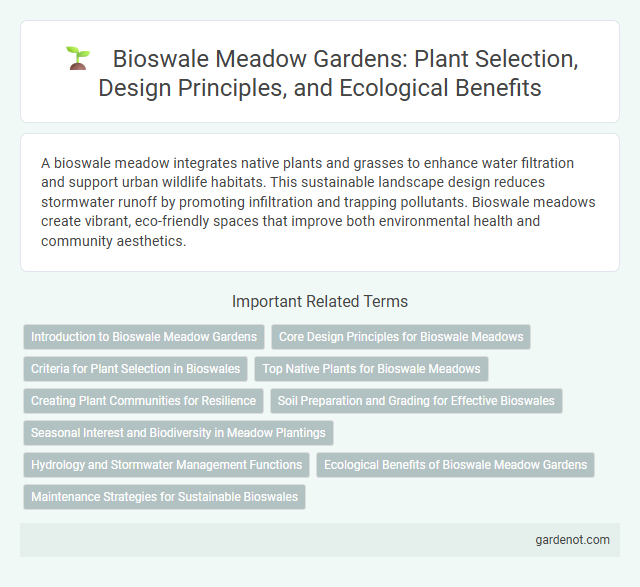A bioswale meadow integrates native plants and grasses to enhance water filtration and support urban wildlife habitats. This sustainable landscape design reduces stormwater runoff by promoting infiltration and trapping pollutants. Bioswale meadows create vibrant, eco-friendly spaces that improve both environmental health and community aesthetics.
Introduction to Bioswale Meadow Gardens
Bioswale meadow gardens integrate native grasses and flowering plants to enhance stormwater management by filtering pollutants and promoting groundwater recharge. These gardens support biodiversity by providing habitat for pollinators and other beneficial wildlife in urban and suburban landscapes. Effective bioswale design maximizes infiltration while minimizing erosion and sediment buildup, improving both ecological function and aesthetic appeal.
Core Design Principles for Bioswale Meadows
Bioswale meadows integrate native grasses and permeable soil layers to maximize stormwater infiltration and pollutant filtration, enhancing urban water management. Core design principles emphasize slope gradient control between 1-5% to optimize flow velocity, prevent erosion, and support vegetation establishment. Incorporating diverse plant species with deep root systems stabilizes soil, increases water retention, and promotes habitat biodiversity within the bioswale ecosystem.
Criteria for Plant Selection in Bioswales
Plant selection in bioswale meadows prioritizes native species with deep root systems to enhance soil infiltration and stabilize the substrate. Drought-tolerant and pollution-absorbing plants such as sedges, rushes, and native grasses efficiently filter runoff contaminants. Vegetation must also withstand periodic flooding and varying moisture levels to maintain bioswale functionality and ecosystem health.
Top Native Plants for Bioswale Meadows
Top native plants for bioswale meadows include switchgrass (Panicum virgatum), blue flag iris (Iris versicolor), and Joe-Pye weed (Eutrochium purpureum), which excel in water filtration and erosion control. These species thrive in wet conditions, support pollinators, and improve stormwater management by enhancing soil infiltration. Incorporating native sedges like Carex species alongside wildflowers increases biodiversity and resilience within bioswale ecosystems.
Creating Plant Communities for Resilience
Bioswale meadows enhance stormwater management by integrating diverse native plant communities that improve soil infiltration and reduce runoff. Selecting resilient species with varying root structures supports pollutant filtration and stabilizes the soil against erosion. These tailored plant assemblies foster biodiversity and increase ecosystem resilience to climate variations and urban stressors.
Soil Preparation and Grading for Effective Bioswales
Soil preparation for bioswale meadows involves deep tilling and amending with organic matter to enhance infiltration and nutrient retention. Proper grading ensures a gentle slope, typically between 1-5%, directing stormwater efficiently while preventing erosion and pooling. These measures optimize bioswale performance by promoting healthy vegetation growth and maximizing water filtration.
Seasonal Interest and Biodiversity in Meadow Plantings
Bioswale meadows enhance seasonal interest through a diverse array of native grasses and flowering plants that bloom from early spring to late fall, supporting continuous habitat value. These plantings increase biodiversity by providing essential resources such as nectar, pollen, and shelter for pollinators, birds, and beneficial insects throughout changing seasons. The strategic selection of species with varied bloom times and structural diversity promotes ecological resilience and sustained ecosystem services in urban landscapes.
Hydrology and Stormwater Management Functions
Bioswale meadows enhance hydrology by facilitating the infiltration and filtration of stormwater, reducing runoff volume and peak flow rates. Their dense vegetation and engineered soil media improve pollutant removal, promoting groundwater recharge and mitigating urban flooding risks. Effective bioswale design supports sustainable stormwater management by maintaining natural water cycles and enhancing watershed health.
Ecological Benefits of Bioswale Meadow Gardens
Bioswale meadow gardens enhance urban ecosystems by improving stormwater management through natural filtration and sediment capture, reducing runoff pollution in local waterways. These gardens support biodiversity by providing habitat for pollinators, birds, and beneficial insects while promoting soil health with deep-rooted native plants that prevent erosion. Integrating bioswale meadows into landscapes mitigates heat island effects and contributes to carbon sequestration, reinforcing ecological resilience and sustainability.
Maintenance Strategies for Sustainable Bioswales
Effective maintenance strategies for sustainable bioswale meadows include regular inspection and removal of accumulated sediment to prevent clogging and ensure optimal water infiltration. Periodic pruning of native vegetation helps maintain healthy plant growth, enhances pollutant filtration, and promotes biodiversity. Irrigation management during dry periods supports plant vitality, while adaptive management techniques address invasive species and changing environmental conditions to sustain long-term performance.
Bioswale meadow Infographic

 gardenot.com
gardenot.com